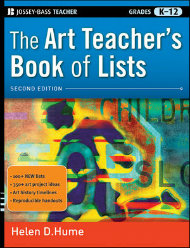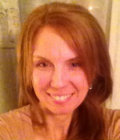Promote Creativity with The Art Teacher’s Book of Lists
The Art Teacher’s Book of Lists (2nd Edition)
By Helen D. Hume
(Jossey-Bass/Wiley, 2010 – Learn more)
In the author’s own words, The Art Teacher’s Book of Lists (2nd Ed.) contains “…everything you wanted to know about art and didn’t know whom to ask.” Without a doubt, she’s right. Helen Hume offers K-12 teachers 400 pages of valuable art-related resources all within the cover of one book. While that might sound a little overwhelming, it’s not – thanks to the author’s meticulous organization.

1. Basic Information for the Art Teacher
2. Museums and Educational Collections
3. Artists and Art History
4. Diverse Cultures
5. Literature and Supply Resources
6. Definitions of Art Tools and Materials
7. Painting, Drawing, and Printmaking
8. Photography and Digital Arts
9. Sculpture and Ceramics
10. Architecture
11. Art Projects
12. Schools and Careers in Art
A strong sense of what teachers need
Each chapter begins with insightful quotations about art and the creative process, primarily in the words of artists themselves. The author then subdivides the chapters into smaller, more manageable sections with very straightforward titles.
In Chapter 1, for example, Hume offers a section called “Pronunciation Guide.” Who hasn’t at one point or another paused before uttering words like Beaux-Arts or Paul Klee? By including a section like this, the author helps teachers overcome one of the most obvious and yet ever-real barriers to discussing art in the classroom. In subsequent chapters, Hume provides everything from historical timelines to media-specific terminology to how to prepare an art school admissions portfolio.
Not just for Art teachers
The true value of this book, however, lies in the wealth of art information available to the non-art teacher. This book should really be called The Teacher’s Book of Art Lists. As a 6th grade language arts teacher, I’m always looking for ways to incorporate the arts into my lessons. Hume offers specific sections to do just that, including titles like “One-Hour Projects,” “Ten Ideas for Combining Arts with Language Arts,” and specific project ideas in almost every visual art medium. Teachers with or without backgrounds in art will find a plethora of information to help integrate the arts into any discipline and find starting points for interdisciplinary projects.
While certain projects might need a traditional art room setting, many ideas require little more than the basic supplies found in a typical classroom. For example, Section 11-26 details various two and three-dimensional projects students can create simply with paper. One project (which Hume also includes in her 2000 book A Survival Kit for the Elementary/Middle School Art Teacher), is the large stuffed animal sculpture. Students can create a three-dimensional object by folding craft paper, cutting out a shape, stuffing it with newspaper, and stapling it shut.
I used this project in my classroom a few years ago when my 8th graders were studying Australia. The students transformed the room into an out-sized map of Australia with large stuffed paper animals suspended from the ceiling over strategic locations. It was a fun and meaningful way for students, even the ever-so-cool 8th graders, to demonstrate an understanding of their research.
In our age of Common Core Standards and short research projects, it’s beneficial to have creative options like those suggested by Hume to avoid the standard research paper rut.
Minor quibbles / Major recommendation
There are a few minor weak spots in The Art Teacher’s Book of Lists, including some index references that don’t quite match, an over-generalized section on so-called universal symbols (you might not want to discuss that Brazilian hand symbol in Italy!), and not as much about 21st century media as I would have hoped.
Overall, however, I would definitely recommend this book because it offers teachers of all grades and all levels of art knowledge many concrete ways to engage students in the creative thinking process and to address more learning styles in the classroom.
Julia Colombo is a sixth grade language arts teacher at Mattoon Middle School in Mattoon, Illinois. In addition to serving as team leader, she sponsors an after-school student arts and writing group called The P.A.W. She also currently serves as the president of the East Central-EIU chapter of the Illinois Reading Council and sits on the editorial advisory board for the Illinois Reading Council Journal.
ALSO SEE: Carrie Manders’ MiddleWeb review of The Art Teacher’s Book of Lists by Helen Hume.



































